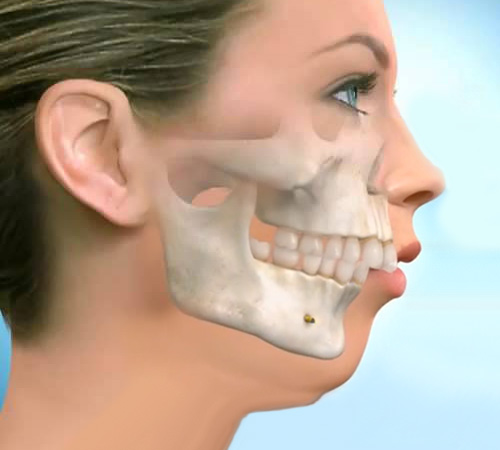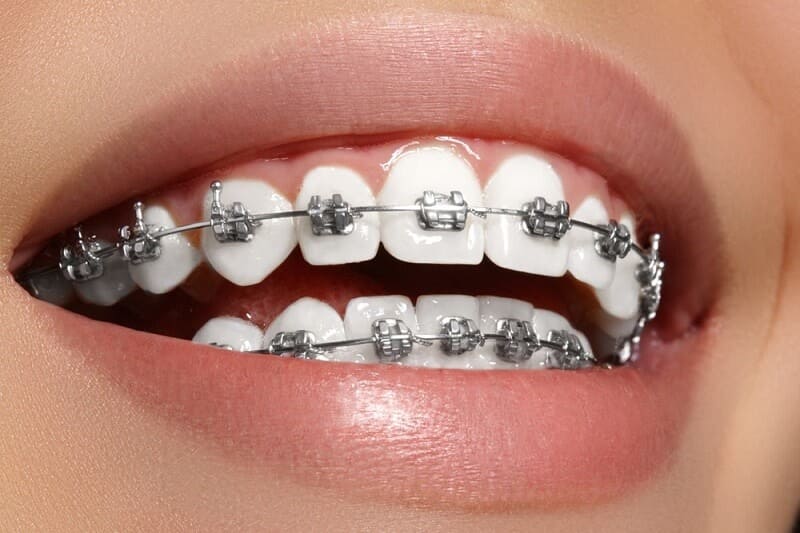Protruding Front Teeth — How to Fix the Problem

Contents:
Most often, the two central teeth protrude forward due to crowded teeth and significant dentition pressure. Also, the reason may be their initially incorrect position. But the bite violation may appear to develop after the correction. Therefore, it is a fair assumption to say that flared teeth after wearing braces are an orthodontic problem that most of us are familiar with.
The lack of space in the dental line in the case of the abnormal size of these teeth, as well as distal bite (the upper jaw is pushed forward more than the lower one), can cause protruding front teeth. Protruding teeth problems range from mild to severe and worsen over time if left untreated

It is worth noting that with a correct (orthognathic) bite, the upper jaw usually protrudes slightly forward than the lower.
Protruding Front Teeth
Protruding teeth are a common dental symptom many people suffer from. Large front teeth can lower a person’s self-confidence and worsen their overall quality of life. Although protruding teeth are associated with minor health complications, many people want to correct them due to their unaesthetic appearance. Fortunately, there are various methods for restoring protruding teeth in adults.
A bad bite is such a misalignment of teeth in the jaw that it does not meet physiological norms and functional needs.
Orthodontic bites with the upper incisors (upper front teeth) overlap the lower incisors by about a third of the height of the dental crowns is accepted as the norm.
Why Do the Front Teeth Protrude?
There can be different causes of protruding teeth, and some of the most common are:
- Tongue thrust: teeth protrusion can result from the tongue pressing too far forward in the mouth, pushing front teeth forward. It should be emphasised that tongue protrusion is caused by chronic adenoiditis or tonsils, improper swallowing, stress, and poor sleep habits. Sometimes, when children constantly suck their thumb, this can be a reason for protruding teeth and an open bite in adulthood.
- Jaw tumours and cysts: although very rare, cysts and tumours can lead to misalignment of the teeth and cause the teeth to buck.
- Periodontal disease: some periodontal diseases can also cause teeth to protrude due to bone loss and mobility. Periodontal disease can loosen teeth, causing them to move apart and stretch.
- Missing, extra, damaged teeth. Another major cause of protruding teeth is a gap or crowding. Missing teeth can also cause the remaining teeth to shift over time, causing them to protrude. Finally, extra (supernumerary) teeth can lead to bite problems.
- Genetics. Another common cause of protruding teeth is genetic predisposition. Some people have congenital malformations of the upper or lower jaw. Due to the underdevelopment of the jaw, there is no room for all the teeth. Conventional treatment for a genetically determined protruding tooth includes orthodontic treatment during childhood or adolescence. Sometimes this condition can require surgery.

Concomitant disorders may occur due to malocclusion. Here are some common issues you may encounter:
- Tooth enamel damage
- Increased risk of periodontal disease
- Teeth grinding
- Breathing problems
- Discomfort when biting or chewing
- Speech disorders
- Jaw pain
- Severe headaches
Can Teeth Position Be Corrected?
Definitely yes! Now that we’ve discussed the various causes of crooked teeth in adults let’s look at some of the common treatments available to correct this condition. It is important to note that direct veneers are not a means of bite correction and can only be used after the final alignment of the dentition.
Braces on the front teeth are one of the traditional and most effective ways to treat protruding teeth. Invisible braces (aligners) are now also available to fix your protruding teeth without people even noticing.
Aligners are also an excellent tool for correcting the position of teeth.
Ways To Fix the Defect
Braces are one of the most effective methods for correcting adult malocclusion. As the first step in correcting an overbite with braces, your orthodontist will take diagnostic images and models of your teeth. The goal is to determine your overbite problem and how your teeth and jaws align. Then, your dentist will place braces on your upper and lower teeth and fix archwires of a specific size and shape in the braces slots. Further, additional devices in the form of elastic bands are applied to move the teeth and jaw into the correct position.

Correction Final Stage
The final step in correcting an overbite with braces is to fix a retainer or plastic mouth guard (night guard).
There are several types of braces according to their location:
- Classic vestibular (on the outside of the teeth);
- Lingual braces (inside teeth surface);
- Removable appliances can also be used for treatment.
When looking for a treatment to correct misaligned or crooked teeth, check with your orthodontist to find out which option is best for you.
If you have crooked teeth, it is in your best interest to get braces as soon as possible. Grinding your teeth and clenching your jaws can damage your teeth. Sometimes, malocclusion can interfere with your routine oral hygiene and make it difficult to brush your teeth, increasing the risk of cavities and periodontal disease.
Many people ask the question: how long does braces treatment take?
Each case is different, but severe malocclusion may require braces treatment for at least 24 months. After the orthodontist has removed the braces, a retainer is fixed to keep the teeth from moving.
What Are Other Options Available to Correct Malocclusion?
Palatal Expansion
Your dentist will recommend that you wear a palate expander or other modifications that help stretch the palatal suture and expand the lateral areas to create space for the teeth if there is not enough space in the upper jaw.
Surgery
Sometimes, there is a need for surgery in orthodontic treatment on the upper jaw and extraction of third molars (wisdom teeth) or removal of a specific tooth with the correct calculation to achieve the result. Corrective bite surgery is recommended for adult patients who cannot have their jaw widened to correct the problem of malocclusion.
Children usually don’t need them because their teeth and bones are developing and are much easier to move with traditional braces and appliances.
Tooth Extraction
Correcting malocclusion by removing a tooth is a forced decision if the problem is related to crowding. Removing one or more teeth allows the remaining teeth to move to their correct position. With proper teeth alignment, the jaws also return to their normal position.
Consequences of Malocclusion
Malocclusion can cause chewing and swallowing problems. A person may experience jaw pain or clicking when chewing. In addition, crooked teeth make it difficult to break down food into smaller pieces, which can also affect digestion.
Many people ask if braces are a good option for correcting an overbite. The answer to your question is “Yes”. Braces can help teens and adults achieve perfect teeth and harmonious smiles. During treatment with removable dental appliances, your orthodontist will design a set of individually adapted clear plastic aligners. Then, you will need to wear several forms until your teeth align.
Wearing aligners to correct misaligned or crooked teeth is more common among adults as they are nearly invisible compared to traditional braces that come with metal and wires.

